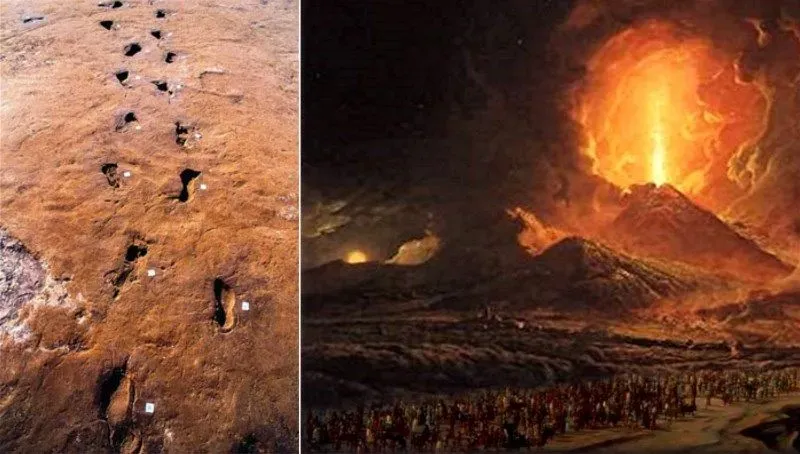Have you ever wondered what stories the earth could tell if it could speak? Recently, workers digging for a pipeline near Pompeii, Italy, stumbled upon an amazing discovery that does just that! They found ancient footprints made by people and animals escaping a volcanic eruption from Mount Vesuvius, long before the famous eruption that buried the city of Pompeii in 79 CE. These footprints, dating back to the Bronze Age, reveal a dramatic moment in history when life was turned upside down. Let’s explore how these fascinating discoveries help us understand the past and the powerful forces of nature!
| Category | Details |
|---|---|
| Event | Discovery of Bronze Age footprints and archaeological features during methane pipeline maintenance near Pompeii. |
| Date of Discovery | February 3, 2025 |
| Location | Near Pompeii, Italy, south of Naples. |
| Significant Findings | Human and animal footprints from the Bronze Age, evidence of ancient huts, religious sanctuary, and agricultural artifacts. |
| Historical Context | Footprints may relate to the Avellino eruption, a powerful event over 3,780 years ago, predating the famous 79 CE eruption. |
| Footprint Details | Footprints found in pyroclastic deposits, indicating a dramatic escape from volcanic activity. |
| Other Archaeological Evidence | Reconstruction of over 40 roads, including ancient wagon wheel ruts, and various burial sites. |
| Cultural Insights | Findings reveal coexistence of Christian and pagan burial practices, showing adaptability of ancient communities. |
| Impact on Infrastructure | Excavations limit construction work in the area due to the presence of archaeological material. |
The Surprising Discovery Beneath Our Feet
Imagine working on a simple project and suddenly finding treasures from the past! That’s what happened when workers in Italy were fixing a pipeline. They accidentally uncovered footprints and other artifacts that were thousands of years old. These discoveries were made near Pompeii, a famous city that was buried by a volcanic eruption. This exciting find shows how our world is filled with hidden stories waiting to be discovered.
The footprints found are from the Bronze Age, which was a long time before the well-known eruption of Mount Vesuvius in 79 CE. Scientists believe these footprints might belong to people and animals trying to escape an earlier eruption. This shows that the area has a long history of volcanic activity, and people have always had to face the dangers of living near a volcano. Each discovery helps us learn more about how people lived and survived in the past.
Understanding the Impact of Mount Vesuvius
Mount Vesuvius is a volcano that has erupted many times throughout history. The most famous eruption in 79 CE destroyed the cities of Pompeii and Herculaneum. However, the discovery of Bronze Age footprints suggests that another powerful eruption happened long before this event. Scientists think it occurred about 3,780 years ago and was even more violent than the one that buried Pompeii. This highlights how volcanoes can change lives and landscapes, leaving behind clues for us to find.
The footprints found in the excavations serve as a reminder of the dangers posed by volcanoes. When Mount Vesuvius erupted, it created hot clouds and ash that could quickly bury everything in their path. This means that ancient people had to be very aware of their surroundings. The footprints show us that they were able to escape in time, but not all were so lucky. Understanding these events helps us appreciate the resilience of communities facing natural disasters.
Life and Culture Around Pompeii
The area around Pompeii was not just a place of destruction; it was also home to vibrant communities. Archaeologists have found evidence of homes, roads, and even religious sites that date back to ancient times. These discoveries help us understand how people lived, what they built, and how they worshiped. The semicircular huts and roads show that people had a structured way of life, with trade routes and places to gather for worship and community.
As researchers explore the area, they also uncover different burial practices. Some graves show how multiple cultures coexisted, with both Christian and pagan traditions. This variety teaches us about the beliefs and customs of ancient people. By studying these sites, we learn how human societies adapt and change over time, reflecting the rich tapestry of history that shapes our world today.
The Significance of Bronze Age Footprints in Archaeology
The discovery of Bronze Age footprints near Pompeii is significant, as it provides a rare glimpse into the lives of ancient inhabitants before the catastrophic eruption of Vesuvius in 79 CE. These footprints not only serve as evidence of human and animal activity but also highlight the vulnerability of communities living in the shadow of an active volcano. Such findings offer archaeologists invaluable insights into the behaviors and responses of populations during volcanic events, enriching our understanding of human resilience.
Furthermore, the footprints are a poignant reminder of the long history of volcanic activity in the region. They suggest that the inhabitants had experienced prior eruptions, yet continued to settle in these fertile lands. This duality of attraction and danger illustrates the complex relationship between humans and their environment, emphasizing the need for ongoing research into how ancient societies adapted to natural disasters, a theme that resonates with contemporary discussions about climate change and disaster preparedness.
Uncovering Layers of History: The Archaeological Excavation Process
The excavation process near Naples unearthed not only footprints but also a wealth of artifacts and structures spanning centuries. This meticulous work involves careful stratigraphic analysis, which helps archaeologists understand the sequence of human activity over time. Each layer of soil can reveal different historical periods, allowing researchers to piece together a comprehensive narrative of the region’s past, from Bronze Age settlements to Roman agricultural practices.
Moreover, the discovery of religious sanctuaries and burial sites indicates the cultural and spiritual dimensions of these ancient communities. Items found at these sites often include votive offerings, which provide insights into the beliefs and rituals of the time. As excavations continue, they offer an opportunity to learn about the social dynamics, trade practices, and everyday life of people who lived in close proximity to one of the world’s most famous volcanoes.
The Avellino Eruption: A Precursor to Pompeii’s Fate
Scientists believe that the footprints may correlate with the Avellino eruption, a cataclysmic event that struck approximately 3,780 years ago. This eruption was more powerful than the one that buried Pompeii, raising questions about how effectively ancient communities could respond to volcanic threats. The Avellino eruption serves as a crucial case study in understanding the geological history of Mount Vesuvius and the persistent risks it poses to local populations.
The powerful surges and fallout from the Avellino eruption not only reshaped the landscape but also likely influenced settlement patterns in the region. By studying the impact of this earlier disaster, researchers can draw parallels to the later destruction of Pompeii, providing insights into the long-term consequences of volcanic activity. This understanding helps to inform modern volcanic risk assessments and community preparedness strategies, bridging the gap between ancient and contemporary disaster management.
Cultural Reflections in the Remains of Ancient Communities
The remnants of semicircular huts and religious sanctuaries discovered during the excavation provide a fascinating window into the cultural practices of ancient societies. These structures reflect the social organization, architectural choices, and spiritual beliefs of inhabitants during the Bronze-Iron Age transition. The diversity of artifacts reveals a rich tapestry of daily life, from agricultural practices to religious rituals, shedding light on how communities adapted to their environment.
Additionally, the presence of both Christian and pagan burial practices illustrates the coexistence of different belief systems during the Late Antiquity period. This blending of traditions highlights the dynamic nature of human culture, as communities evolved in response to changing socio-political landscapes. Such findings enrich our understanding of historical interactions and transformations, reminding us of the enduring impact of cultural heritage on contemporary society.
Frequently Asked Questions
What happened when workers dug for a pipeline near Pompeii?
Workers found **ancient artifacts** while digging a methane pipeline. They discovered **footprints** from the Bronze Age, showing how people and animals ran away from a volcanic eruption long before Pompeii was buried.
Why are the footprints found near Pompeii important?
The **footprints** are important because they show how people and animals reacted to a **volcanic eruption**. They tell us about **ancient life** and the dangers of living near **Mount Vesuvius**.
What does pyroclastic deposits mean?
**Pyroclastic deposits** are layers of volcanic debris, like ash and rocks, that fall during a **volcano’s eruption**. They can preserve things, like **footprints**, for thousands of years.
How did archaeologists know the footprints were from a volcano?
Archaeologists recognized the **footprints** were from a volcano because they were found in **pyroclastic deposits**. These deposits are often created during powerful eruptions, showing evidence of an **explosive event**.
What kind of buildings were found during the excavation?
The excavation revealed **semicircular huts** from the Bronze Age and a **religious sanctuary** from the second century BCE. This shows how people lived and worshipped many years ago.
What does the return to longhouse style buildings mean?
The return to **longhouse style** buildings means people went back to using **long, narrow huts** for homes. This change shows how communities adapt to new challenges and ways of living.
How did the findings help us understand ancient cultures?
The findings give us a glimpse into **ancient cultures** by showing different **habitats**, burial practices, and how people responded to **natural disasters** like volcanic eruptions.
Summary
The content discusses a significant archaeological discovery made during pipeline maintenance in Italy, revealing evidence of human and animal footprints from the Bronze Age, potentially linked to an eruption of Mount Vesuvius over 3,700 years ago. This discovery highlights the dramatic escape of inhabitants from a volcanic disaster, predating the well-known 79 CE eruption that buried Pompeii. Alongside footprints, excavations uncovered ancient huts, a religious sanctuary, and burial sites, showcasing the region’s rich history and agricultural practices. Overall, these findings offer valuable insights into the adaptability and resilience of human communities in response to environmental changes.








